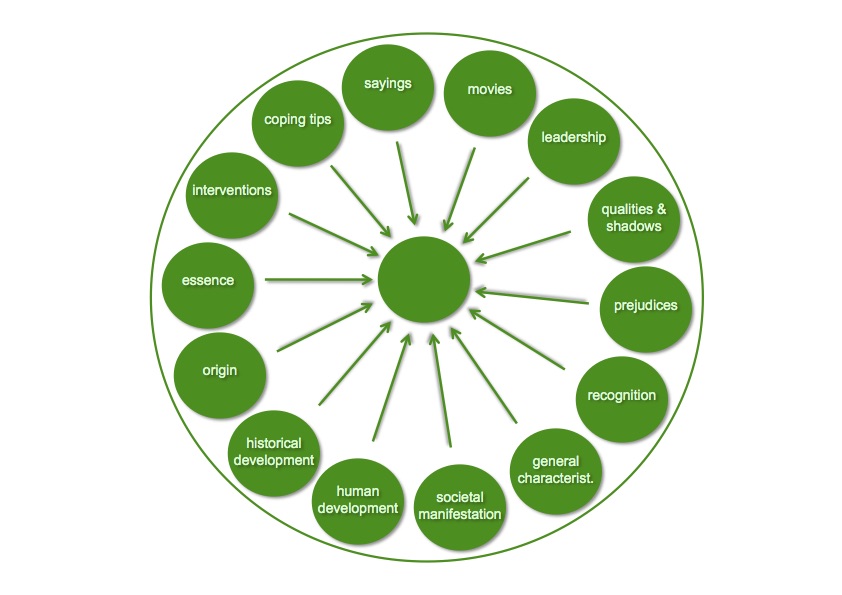Characteristics Green Value System
On this page, you will, step by step, find the most important characteristics of the Green value system. Please click on a subject to navigate to the text. The image on the right-hand side of this page is an example of an organization form that is typical for Green.
What is the essence of the Green value system?
Core Values:
Relativistic, socio-centric, equality.
Paradigm:
Community “ We become”
Word View:
The world is a shared community for the whole of humanity who shares Mother Earth as their home.
Life Motto:
“I sacrifice myself now to be accepted by the group”
Life Theme:
Welfare, love, find meaning in life, personal growth and to live in harmony with others and with the Earth.
Life Philosophy:
I feel emotions, therefore I am alive. In essence, everyone is equal.
What is the origin of the Green value system?
Period:
200 years ago
Geographical Location:
France and Germany
Founders:
Philosophers regard humans as both part of nature and as the ones who determine their own role in the existential game.
In reaction to::
In the fast, dynamic and material world of Orange it is slowly recognized that material wealth alone is not sufficient to live a satisfying existence. Moreover, the boundaries of a makeable world become apparent. People start to realize that not everything can be explained and solved with reason and ratio and that complex problem, caused by humans, need more than cognitive thinking alone. There is not only a need for achieved tangible wealth but also a need for more emotional well being. People get interested in their inner worlds and consciousness about emotions takes over. In this world of emotions, people realize that every human is in fact equal and that everybody has a right to live a good life. Abundance may be shared and it’s the responsibility of the haves to take care of the have-nots. Moreover, the world is seen in a larger context. Orange viewed the world as being a market place, Green views the world as a community where, in essence, everybody is equal and where we collectively need to take care of our Planet.
What did humans develop when the Green value system was first activated?
Introspection, inner emotional life, empathic abilities, group and consensus way of thinking and acting, open-minded.
What are the characteristics of the historical development of Green?
Energy Sources:
“Green” energy sources (solar and wind energy) and biomass.
Highlights:
Romance, existentialism, flower power, societal renewal in the sixties and the New Age movement.
Lowlights:
Political correctness, narcism, naïveté, a blind trust in consensus and isolating sectarianism.
Economics:
Sustainable economics and corporate social responsibility.
Religion:
Spirituality, everybody has access to his or hers Divine essence through inner work.
Cultural Theme:
Expression of emotional value and the subconscious
Art Forms:
Romance, Expressionism, Cobra and the New Age peace movement.
Leaders:
Societal spokespersons, gurus, idealists, servant leaders and activists.
Invention:
“Polder model” the Dutch consensus-based economic and social policy making, and the political “Derde Weg”, (literally “Third Road”) a political model which is based on community, opportunity, responsibility and accountability as seen in, for example, the politics by Bill Clinton and Tony Blair.
Modernization:
Environmental consciousness, acceptance of homosexuality and immigrants, New Age and sexual freedom.
What are the manifestations of Green as the dominant value system in our society?
Community forms:
Communes, United Nations and NGOs.
Communities:
Scandinavia, the Netherlands, Canada, California and Belgium.
In the Netherlands:
Progressive Left, New Age and environmental action groups.
What are the general characteristics of the Green value system?
- Strives for harmony, unity and consensus
- Relationships, sharing and bonding
- Ecological and environmental consciousness
- Egalitarian, relativistic, and political correctness
- Idealistic, humanistic and pacifistic
- Tolerant and acceptant of different views
- Emotional, sensitive, and caring
- Personal growth, spirituality and introspection
- Ideological and attention for the life environment and the Planet
- Development of compassion and social networks
- Process orientation, communication and dialogue
- Knowledge sharing, decentralization and bottom up
How do you recognize the presence of Green?
You can recognize Green by striving for harmony, enriching the inner world and the need to make real (on an emotional level) contact with each other. Green will accept the other as he or she is and likes to work together to stimulate individual development, so people can become who they really are. Green is open-minded and accepts differences in people and in opinions.
How do you recognize the absence of Green?
A lack of mutual values and norms. There is not a lot of togetherness and there’s a lack of relational contact. Emotions do not play a part or are denied, avoided and/or are not taken seriously. Talking about people and not with people. Conversations are focused on results, functionality and facts and the human dimension is not taken into account.
How to deal with the Green value system?
Green is proces-driven. It’s important to have the proces prevail the results. Make time and space to discuss emotions, discoveries and experiences so people can learn from each other. It is essential to address all what is happening on an emotional level and share and bond with each other beyond only being goal-orientated. Keep an eye on the group and have a preference for harmony. Do not exclude anyone and have everybody have his or her say if desired.
What are positive stimuli for Green?
Make room for reflection. Stimulate sharing feelings and openness. Make ‘real’ contact and do not only talk about ‘business’. Allow people the freedom to express themselves. Accept different views and opinions. Rate everything at its true value and name things as they are.
What are negative stimuli for Green?
Too much focus on the results, facts, figures and the work to be done. Typecasting, categorizing and labeling people. Make yourself the most important person in the room.
Essentially, Green is not good or bad. Green exists. And we distinguish healthy and unhealthy manifestations of Green.
What are healthy manifestations of Green?
Attention for emotions and exploring the inner being of self. A need for community and gathering. Personal development as the basis for collective development. Accepting differences. Attention, care and compassion for all people and the Planet. Open, loving, warm, empathic and helpful.
What are unhealthy manifestations of Green?
Appeasing, avoiding conflicts, soft and patronizing. Conflicts are not addresses because harmony is more important and should not be compromised. When Green adopts her own wisdom as the only truth it becomes limiting and exclusive and it will exclude everyone who’s not Green. Conversations tend to take longer and results may not be achieved because of the continuous search for consensus and the need to include everyone in the process.
Which prejudices may other value systems have about Green?
- Purple may experience Green as very consensus-focused and too harmonious, which leaves little room for natural structures. Green is too much in the here-and-now and has not enough eyes for the original traditions and relationships.
- Red may experience Green as slow, vague and unclear. Red experiences Green as a hothouse; it’s extremely preoccupied with feelings, and conflicts are not resolved and expressed but remain repressed. Red may also be irritated by Green’s lack of decisiveness and focused action.
- Blue finds it difficult to acknowledge process-focused Green. According to Blue, Green is too occupied with interpersonal relationships, and rules, agreements, procedures and structures are not respected. Blue may distrust Green, because it can and is allowed to change her opinions and focus based on changing conditions. This is why Blue finds it difficult to depend on Green.
- Orange may experience Green as unfocused, woolly and not much focused on results. The Green consensus culture may bother Orange a lot, as it yields little progress. Moreover, Orange thinks Green is excessively occupied with feelings and human inner emotional layers. According to Orange, there are also other factors that enable a person and/or an organization to function as it does.
- Yellow thinks Green assumes that her truth is the only truth and may accuse Green to not acknowledge the real essence of each value system. Yellow experiences Green to be too group-focused leaving relatively little space for the individual freedom. Yellow may be bothered about Green talking about everything and having opinions about it, but not acting on it in a concrete way.
What are typical Green leadership characteristics?
- Give attention to everyone and give everyone the space to be heard.
- Stimulate people to become their real self.
- Accept every person completely in their own individuality.
- Be process-orientated: it’s about the process, not about the result.
- Involve people in decisions and initiatives. Create support for important changes. Give people their own responsibility.
- Create an open atmosphere. Also create space for “save” vulnerability.
- Guard the human dimension.
- Good listener, be authentic as a human with emotions.
- Make things personal and be involved in it.
What are appropriate interventions when dealing with individuals and groups in Green?
Teamwork
To work together, it is essential to make real contact. This means that people are able to bond on an emotional level. This asks for a lot of communication, understanding and empathy.
Gaining trust
Be genuinely interested in the other. Ask about emotions and also show your own vulnerability. Put yourself in an equal position towards the other.
Confronting
Always assume dialogue and give positive feedback. Also accept the negative aspects of a person (and explain they are not negative). Do not act too direct or too demanding. Give people the space to find the answers within themselves. Keep the confrontation “soft”. It’s better to beat about the bush a little bit, and get to the point in a later stage.
When you find it difficult to relate positively to the Green value system, please read the proverbial phrases below to experience the general accepted wisdom of Green.
- Everything of value is defenseless (famous line by the Dutch poet Lucebert)
- Time heals all wounds
- You must be the change you wish to see in the world
- Love conquers everything
- All you need is love
- Happiness is only true when it’s shared
- To break the ice
- To do something with heart and soul
- What is sauce for the goose is sauce for the gander
- To hearten someone up
- To possess one’s soul in patience
- Still waters run deep
- Let things run their natural course
- To cover something with the cloak of charity



